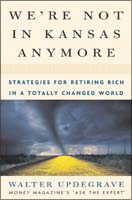Don't count on high returns
If you think 1990s-style gains will bail you out, think again.
NEW YORK (CNN/Money) - I suspect that the relatively high average returns we've had in financial assets over the past two decades have given us an inflated notion of what kind of withdrawals our portfolio can sustain without running dry. But basing a withdrawal strategy on average returns can be dangerous.
Let's assume you retired at 65 with a $500,000 portfolio, 60 percent of which is invested in large-company stocks and 40 percent in intermediate-term government bonds, and you want your retirement portfolio to support you for at least 30 years. Historical average returns would give a misleading take on how much you can withdrawal each year without worry. Large-company stocks delivered an annualized return of more than 12 percent for the 20 years through 2002; intermediate-term bonds over that period returned roughly 9 percent; and that inflation averaged about 3 percent. So, you might reason, it would be okay to each year withdraw 8 percent -- or $40,000 to start, with annual increases for inflation. The reality: If you had embarked on exactly this strategy at the end of 1972, you would have run out of money in less than 10 years, or before you turned 74. Even if you had lowered your withdrawal to just 5 percent -- an initial withdrawal of $25,000 -- the money would have been gone in just under 21 years, when you would have had almost a 50 percent chance of being alive and kicking for years to come. Why did that happen? Because of a little thing known as the 1973-1974 bear market, which knocked the stock market for a 43 percent loss. That enormous loss so early in the period combined with the inflation-adjusted withdrawals to put such a big dent in the portfolio that it wasn't able to recover in time to participate fully in the bull market that began in August 1982. The single most effective thing you can do to ensure that your money will last is to start out with a low withdrawal rate, probably on the order of 4 percent, then raise that amount annually to compensate for a cost-of-living increase or inflation. I'm sure most people would expect to be able to get more than $20,000 a year (before taxes) from a $500,000 portfolio. Tilting your portfolio mix toward stocks can somewhat improve the chances that you won't outlive your funds. But even with an all-stock portfolio, the odds of running out of cash with an initial withdrawal rate of 7 percent that's adjusted for inflation are more than 50 percent. You've also got to remember that the higher the concentration of stocks or stock funds in your portfolio, the more its value will drop during market setbacks. I'm sure many retirees who entered the bear market of 2000 with 80 percent or more of their portfolio in stocks probably wish they'd played it a bit more conservatively. In short, by setting a low initial withdrawal rate, you can get decent odds of your money lasting through a long retirement without having to accept the huge ups and downs you would experience with an all-stock portfolio. |
| |||||||||||

